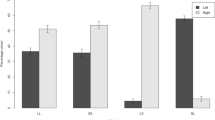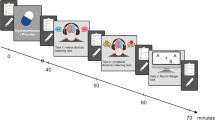Abstract
This study tested dichotic listening performance, a measure of functional cerebral asymmetry previously shown to be sexually dimorphic, in homosexual women (n=23), heterosexual women (n=27), and heterosexual men (n=24). All participants completed a verbal consonant-vowel dichotic listening task. On three laterality indices, heterosexual men displayed a significantly greater right-ear advantage compared to heterosexual women only. Homosexual women did not differ significantly from heterosexual men or from heterosexual women. Post-hoc comparisons (with a statistical correction) for each ear separately showed that heterosexual men displayed significantly greater right-ear scores compared to heterosexual women only. These data suggest that lesbian women are somewhat masculinized in their functional cerebral asymmetry. The results were interpreted in the context of sexual variation in models of linguistic hemispheric processing.
Similar content being viewed by others
References
Alexander, G. M., Altemus, M., Peterson, B. S., & Wexler, B. E. (2002). Replication of a premenstrual decrease in right-ear advantage on language-related dichotic listening tests of cerebral laterality. Neuropsychologia, 40, 1293–1299.
Altemus, M., Wexler, B. E., & Boulis, N. (1989). Changes in perceptual asymmetry with the menstrual cycle. Neuropsychologia, 27, 233–240.
Bryden, M. P. (1982). Laterality: Functional asymmetry in the intact brain. San Diego, CA: Academic Press.
Cohen-Bendahan, C. C. C., Buitlaar, J. K., van Goozen, S. H. M., & Cohen-Kettenis, P. T. (2004). Prenatal exposure to testosterone and functional cerebral lateralization: A study of same-sex and opposite-sex twin girls. Psychoneuroendocrinology, 29, 911–916.
Davidson, R. J., & Hughdahl, K. (1995). Brain asymmetry. Bradford, England: MIT Press.
Geschwind, N., & Galaburda, A. M. (1985a). Cerebral lateralization, biological mechanisms, associations, and pathology: I. A hypothesis and a program for research. Archives of Neurology, 42, 428–459.
Geschwind, N., & Galaburda, A. M. (1985b). Cerebral lateralization, biological mechanisms, associations, and pathology: II. A hypothesis and program for research. Archives of Neurology, 42, 521–552.
Govier, E., & Bobby, P. (1994). Sex and occupation as markers for task performance in a dichotic measure of brain asymmetry. International Journal of Psychophysiology, 18, 179–186.
Govier, E., & Boden, M. (1997). Occupation and dichotic listening performance. Laterality, 2, 27–32.
Govier, E., & Feldman, J. (1999). Occupational choice and patterns of cognitive abilities. British Journal of Psychology, 90, 99–108.
Hampson, E. (1990). Estrogen-related variations in human spatial and articulatory-motor skills. Psychoneuroendocrinology, 15, 97–111.
Hausmann, M., & Gunturkun, O. (2000). Steroid fluctuations modify functional cerebral asymmetries: The hypothesis of progesterone-mediated interhmispheric decoupling. Neuropsychologia, 38, 1362–1374.
Hines, M., & Shipley, C. (1984). Prenatal exposure to diethylstilbestrol (DES) and the development of sexually dimorphic cognitive abilities and cerebral lateralization. Developmental Psychology, 20, 81–94.
Hiscock, M., Inch, R., Jacek, C., Hiscock-Kalil, C., & Kalil, K. M. (1994). Is there a sex difference in human laterality? I. An exhaustive survey of auditory laterality studies from six neuropsychology journals. Journal of Clinical and Experimental Neuropsychology, 16, 423–435.
Hiscock, M., Israelian, M., Inch, R., Jacek, C., & Hiscock-Kalil, C. (1995). Is there a sex difference in human laterality? II. An exhaustive survey of visual laterality studies from six neuropsychology journals. Journal of Clinical and Experimental Neuropsychology, 17, 590–610.
Hugdahl, K. (1988). Handbook of dichotic listening: Theory, methods, and research. New York: Wiley.
Kimura, D. (1961). Cerebral dominance and the perception of verbal stimuli. Canadian Journal of Psychology, 15, 166–171.
Kuhn, G. M. (1973). The phi coefficient as an index of ear differences in dichotic listening. Cortex, 9, 450–457.
Mathews, G. A., Fane, B. A., Pasterski, V. L., Conway, G. S., Brook, C., & Hines, M. (2004). Androgenic influences on neural asymmetry: handedness and language lateralization in individuals with congenital adrenal hyperplasia. Psychoneuroendocrinology, 29, 810–822.
McCormick, C. M., & Witelson, S. F. (1994). Functional cerebral asymmetry and sexual orientation in men and women. Behavioral Neuroscience, 108, 525–531.
McFadden, D., & Champlin, C. A. (2000). Comparison of auditory evoked potentials in heterosexual, homosexual and bisexual males and females. Journal for the Association of Research into Otolaryngology. 1, 89–99.
McFadden, D., & Pasanen, E. G. (1998). Comparison of the auditory systems of heterosexuals and homosexuals: Click-evoked otoacoustic emissions. Proceedings of the National Academy of Sciences, USA, 95, 2709–2713.
McFadden, D., & Pasanen, E. G. (1999). Spontaneous otoacoustic emissions in heterosexuals, homosexuals and bisexuals. Journal of the Acoustical Society of America, 105, 2403–2413.
Mead, L. A., & Hampson, E. (1996). Asymmetric effects of ovarian hormones on hemispheric activity: Evidence from dichotic and tachistoscopic tests. Neuropsychology, 10, 578–587.
Munro, P., & Govier, E. (1993). Dynamic gender-related differences in dichotic listening performance. Neuropsychologia, 31, 347–353.
Rahman, Q. (2005). The neurodevelopment of human sexual orientation. Neuroscience and Biobehavioral Reviews, 29, 1057–1066.
Rahman, Q., Wilson, G. D., & Abrahams, S. (2004). Biosocial factors, sexual orientation and neurocognitive functioning. Psychoneuroendocrinology, 29, 867–881.
Sanders, G., & Ross-Field, L. (1986). Sexual orientation, cognitive abilities, and cerebral asymmetry: A review and a hypothesis tested. Italian Journal of Zoology, 20, 459–470.
Sanders, G., & Ross-Field, L. (1987). Neuropsychological development of cognitive abilities: A new research strategy and some preliminary evidence for a sexual orientation model. International Journal of Neuroscience, 36, 1–16.
Sanders, G., & Wenmoth, D. (1998a). Verbal and music dichotic listening tasks reveal variations in functional cerebral asymmetry across the menstrual cycle that are phase and task dependent. Neuropsychologia, 36, 869–874.
Sanders, G., & Wenmoth, D. (1998b). Cerebral asymmetry and cognitive performance show complementary fluctuations across the menstrual cycle. In L. Ellis & L. Ebertz (Eds.), Males, females, and behavior: Towards biological understanding (pp. 165–175). Westport, CT: Praeger.
Sanders, G., & Wright, M. (1997). Sexual orientation differences in cerebral asymmetry and in the performance of sexually dimorphic cognitive and motor tasks. Archives of Sexual Behavior, 26, 463–480.
Shaywitz, B. A., Shaywitz, S. E., Pugh, K. R., Constable, R. T., Skudlarski, P., Fulbright, R. K., et al. (1995). Sex differences in the functional organization of the brain for language. Nature, 373, 607–609.
Sommer, I. E. C., Aleman, A., Bouma, A., & Kahn, R. S. (2004). Do women really have more bilateral language representation than men? A meta-analysis of functional imaging studies. Brain, 127, 1845–1852.
Studdert-Kennedy, M., & Shankweiler, D. (1970). Hemispheric specialization for speech perception. Journal of the Acoustical Society of America, 48, 579–594.
Voyer, D. (1996). On the magnitude of laterality effects and sex differences in functional brain asymmetries. Laterality, 1, 51–83.
Voyer, D. (1998). On the reliability and validity of non-invasive laterality measures. Brain and Cognition, 36, 209–236.
Weekes, N. Y., Zaidel, D. W., & Zaidel, E. (1995). Effects of sex and sex role attributions on the ear advantage in dichotic listening. Neuropsychology, 9, 62–67.
Wegesin, D. J. (1998a). Relation between language lateralization and spatial ability in gay and straight men and women. Laterality, 3, 227–239.
Wegesin, D. J. (1998b). Event-related potentials in homosexual and heterosexual men and women: Sex-dimorphic patterns in verbal asymmetries and mental rotation. Brain and Cognition, 36, 73–92.
Acknowledgements
We are grateful to the women and men who volunteered their time for this project. This study formed part of the second author’s final year dissertation in fulfilment of a Bachelors of Sciences with honours degree in Psychology.
Author information
Authors and Affiliations
Corresponding author
Rights and permissions
About this article
Cite this article
Rahman, Q., Cockburn, A. & Govier, E. A Comparative Analysis of Functional Cerebral Asymmetry in Lesbian Women, Heterosexual Women, and Heterosexual Men. Arch Sex Behav 37, 566–571 (2008). https://doi.org/10.1007/s10508-006-9137-0
Published:
Issue Date:
DOI: https://doi.org/10.1007/s10508-006-9137-0




